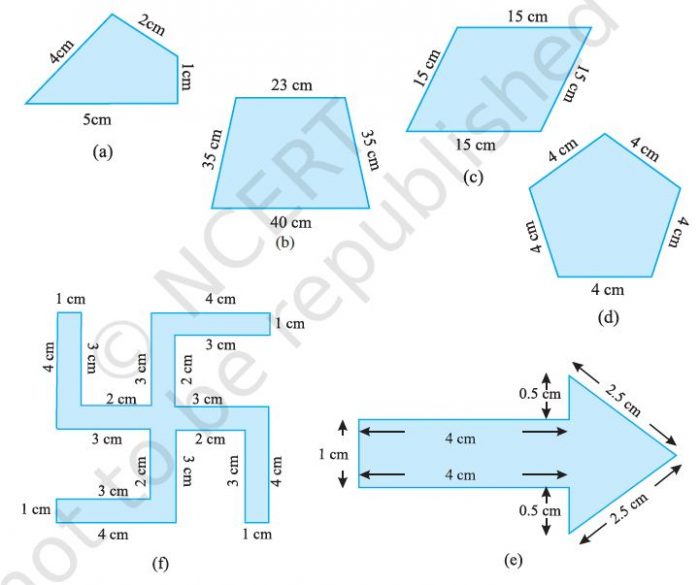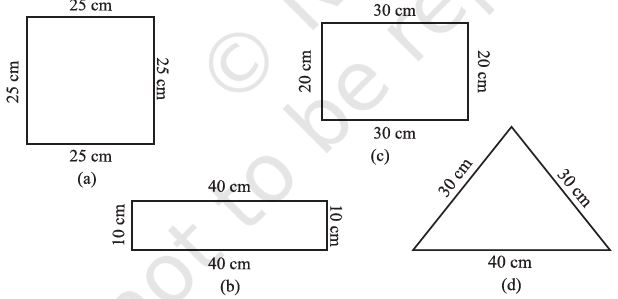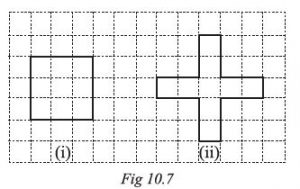NCERT Solutions for Class 6 Mathematics Exercise 10.1
|
NCERT Answers for Class 6 Maths Chapter 10 |
Mensuration Exercise 10.1
Page 212
Ex 10.1 Class 6 Maths Question 1. Find the perimeter of each of the following figures :
Answer
(a) Perimeter = Sum of all the sides
= 1 + 2 + 4 + 5
= 12 cm
(b) Perimeter = Sum of all the sides
= 23 + 35 + 35 + 40
= 133 cm
(c) Perimeter = Sum of all the sides
= 15 + 15 + 15 + 15
= 60 cm
(d) Perimeter = Sum of all the sides
= 4 + 4 + 4 + 4 + 4
=20 cm
(e) Perimeter = Sum of all the sides
= 1 + 4 + 0.5 + 2.5 + 2.5 + 0.5 + 4
= 15 cm
(f) Perimeter = Sum of all the sides
= 4 + 1 + 3 + 2 + 3 + 4 + 1 + 3 + 2 + 3 + 4 + 1 + 3 + 2 + 3 + 4 + 1 + 3 + 2 + 3
= 52 cm
Ex 10.1 Class 6 Maths Question 2. The lid of a rectangular box of sides 40 cm by 10 cm is sealed all round with tape. What is the length of the tape required?
Answer
Length of required tape = Perimeter of rectangle
= 2 (Length + Breadth)
= 2 (40 + 10)
= 2 (50)
= 100 cm
Therefore, required length of tape is 100 cm
Ex 10.1 Class 6 Maths Question 3. A table-top measures 2 m 25 cm by 1 m 50 cm. What is the perimeter of the table-top?
Answer
Length of table top = 2 m 25 cm = 2.25 m
Breadth of table top = 1 m 50 cm = 1.50 m
Perimeter of table top = 2 (Length + Breadth)
= 2 (2.25 + 1.50)
= 2 (3.75)
= 2 × 3.75
= 7.5 m
Therefore, the perimeter of the table top is 7.5 m
Ex 10.1 Class 6 Maths Question 4. What is the length of the wooden strip required to frame a photograph of length and breadth 32 cm and 21 cm respectively?
Answer
Required length of wooden strip = Perimeter of photograph
= 2 (Length + Breadth)
= 2 (32 + 21)
= 2 (53)
= 2 × 53
= 106 cm
Therefore, required length of the wooden strip is 106 cm
Ex 10.1 Class 6 Maths Question 5. A rectangular piece of land measures 0.7 km by 0.5 km. Each side is to be fenced with 4 rows of wires. What is the length of the wire needed?
Answer
Perimeter of the field = 2 (Length + Breadth)
= 2 (0.7 + 0.5)
= 2 (1.2)
= 2 × 1.2
= 2.4 km
Each side is to be fenced with 4 rows = 4 × 2.4
= 9.6 km
Therefore, the total length of the required wire is 9.6 km
Ex 10.1 Class 6 Maths Question 6. Find the perimeter of each of the following shapes :
(a) A triangle of sides 3 cm, 4 cm and 5 cm.
(b) An equilateral triangle of side 9 cm.
(c) An isosceles triangle with equal sides 8 cm each and third side 6 cm.
Answer
(a) Perimeter of triangle = 3 + 4 + 5
= 12 cm
(b) Perimeter of an equilateral triangle = 3 × side
= 3 × 9
= 27 cm
(c) Perimeter of isosceles triangle = 8 + 8 + 6
= 22 cm
Ex 10.1 Class 6 Maths Question 7. Find the perimeter of a triangle with sides measuring 10 cm, 14 cm and 15 cm.
Answer
Perimeter of triangle = 10 + 14 + 15
= 39 cm
Therefore, the perimeter of triangle is 39 cm
Ex 10.1 Class 6 Maths Question 8. Find the perimeter of a regular hexagon with each side measuring 8 m.
Answer
Perimeter of hexagon = 6 × 8
= 48 m
Therefore, perimeter of regular hexagon is 48 m
Ex 10.1 Class 6 Maths Question 9. Find the side of the square whose perimeter is 20 m.
Answer
Perimeter of square = 4 × side
20 = 4 × side
Side = 20 / 4
Side = 5 m
Therefore, the side of the square is 5 m
Ex 10.1 Class 6 Maths Question 10. The perimeter of a regular pentagon is 100 cm. How long is its each side?
Answer
Perimeter of regular pentagon = 100 cm
5 × side = 100 cm
Side = 100 / 5
Side = 20 cm
Therefore, side of the pentagon is 20 cm
Ex 10.1 Class 6 Maths Question 11. A piece of string is 30 cm long. What will be the length of each side if the string is used to form :
(a) a square? (b) an equilateral triangle? (c) a regular hexagon?
Answer
Perimeter of square = 30 cm
4 × side = 30
Side = 30 / 4
Side = 7.5 cm
Perimeter of an equilateral triangle = 30 cm
3 × side = 30
Side = 30 / 3
Side = 10 cm
Perimeter of a regular hexagon = 30 cm
6 × side = 30
Side = 30 / 6
Side = 5 cm
Ex 10.1 Class 6 Maths Question 12. Two sides of a triangle are 12 cm and 14 cm. The perimeter of the triangle is 36 cm. What is its third side?
Answer
Let x cm be the third side
Perimeter of triangle = 36 cm
12 + 14 + x = 36
26 + x = 36
x = 36 – 26
x = 10 cm
Therefore, the third side is 10 cm
Ex 10.1 Class 6 Maths Question 13. Find the cost of fencing a square park of side 250 m at the rate of ₹ 20 per metre.
Answer
Side of square = 250 m
Perimeter of square = 4 × side
= 4 × 250
= 1000 m
Cost of fencing = ₹ 20 per m
Cost of fencing for 1000 m = ₹ 20 × 1000
= ₹ 20,000
Ex 10.1 Class 6 Maths Question 14. Find the cost of fencing a rectangular park of length 175 m and breadth 125 m at therate of ₹ 12 per metre.
Answer
Length = 175 cm
Breadth = 125 m
Perimeter of rectangular park = 2 (Length + Breadth)
= 2 (175 + 125)
= 2 (300)
= 2 × 300
= 600 m
Cost of fencing = 12 × 600
= 7200
Therefore, cost of fencing is ₹ 7,200
Ex 10.1 Class 6 Maths Question 15. Sweety runs around a square park of side 75 m. Bulbul runs around a rectangular park with length 60 m and breadth 45 m. Who covers less distance?
Answer
Perimeter of square = 4 × side
= 4 × 75
= 300 m
∴ Distance covered by Sweety is 300 m
Perimeter of rectangular park = 2 (Length + Breadth)
= 2 (60 + 45)
= 2 (105)
= 2 × 105
= 210 m
Therefore, distance covered by Bulbul is 210 m
Hence, Bulbul covers less distance than Sweety.
Ex 10.1 Class 6 Maths Question 16. What is the perimeter of each of the following figures? What do you infer from the answers?
Answer
(a) Perimeter of square = 4 × side
= 4 × 25
= 100 cm
(b) Perimeter of rectangle = 2 (40 + 10)
= 2 × 50
= 100 cm
(c) Perimeter of rectangle = 2 (Length + Breadth)
= 2 (30 + 20)
= 2 (50)
= 2 × 50
= 100 cm
(d) Perimeter of triangle = 30 + 30 + 40
= 100 cm
All the figures have same perimeter.
Ex 10.1 Class 6 Maths Question 17. Avneet buys 9 square paving slabs, each with a side of 1/2 m. He lays them in the form of a square.
(a) What is the perimeter of his arrangement [Fig 10.7(i)]?
(b) Shari does not like his arrangement. She gets him to lay them out like a cross. What is the perimeter of her arrangement [(Fig 10.7 (ii)]?
(c) Which has greater perimeter? (d) Avneet wonders if there is a way of getting an even greater perimeter. Can you find a way of doing this? (The paving slabs must meet along complete edges i.e. they cannot be broken.)
Answer
(a) Side of square = 3 × side
= 3 × 1 / 2
= 3 / 2 m
Perimeter of Square = 4 × 3 / 2
= 2 × 3
= 6 m
(b) Perimeter = 0.5 + 1 + 1 + 0.5 + 1 + 1 + 0.5 + 1 + 1 + 0.5 + 1 + 1
= 10 m
(c) The arrangement in the form of cross has greater perimeter
(d) Perimeters greater than 10 m cannot be determined.



Leave a Reply